After 11 long months, the Premier League has finally come to a close. In one of the strangest seasons to date, Liverpool finally got their hands on their first Premier League trophy. Other clubs achieved great feats such as Sheffield United’s impressive first season back. Aston Villa are another team who will still be celebrating. Whilst they will be disappointed that they were dragged into a relegation fight, Dean Smith managed to keep his team up on the final day.
In early March, Villa looked very much destined to return to the second flight of English football. A 4-0 thrashing from Leicester left them 19th in the league with only seven wins all season. However, an unlikely source would come to Villa’s rescue. A few days after their 4-0 hammering, the global pandemic brought an abrupt end to the season. The continuation of the Premier League was unknown, however, Villa took no chances and looked to turn things around.
At the time of writing, Villa have just escaped relegation on the final day of the season. A much-improved outfit returned after the break and Dean Smith was able to drag his men across the line. It was clear to see that Villa were an improved unit, however one man stood out from the rest. For much of the season, Jack Grealish had been Villa’s talisman. After project restart, it was the Brazilian, Douglas Luiz, who tipped the scales in Villa’s favour. Luiz showed class throughout the season, however, he seemed at times to struggle to keep up with the pace of the Premier League.
This data analysis will use data and statistics to analyse how Douglas Luiz performed pre and post lockdown. The analysis will indicate how integral he was to Aston Villa remaining in the Premier League.
Aston Villa – The improved outfit
Whilst Douglas Luiz was an important cog in Villa’s system, it is important to understand how they changed as a team. This first section of the analysis will look at how Villa became much more defensively solid. We will then continue to analyse how Douglas Luiz fitted into this style of play.
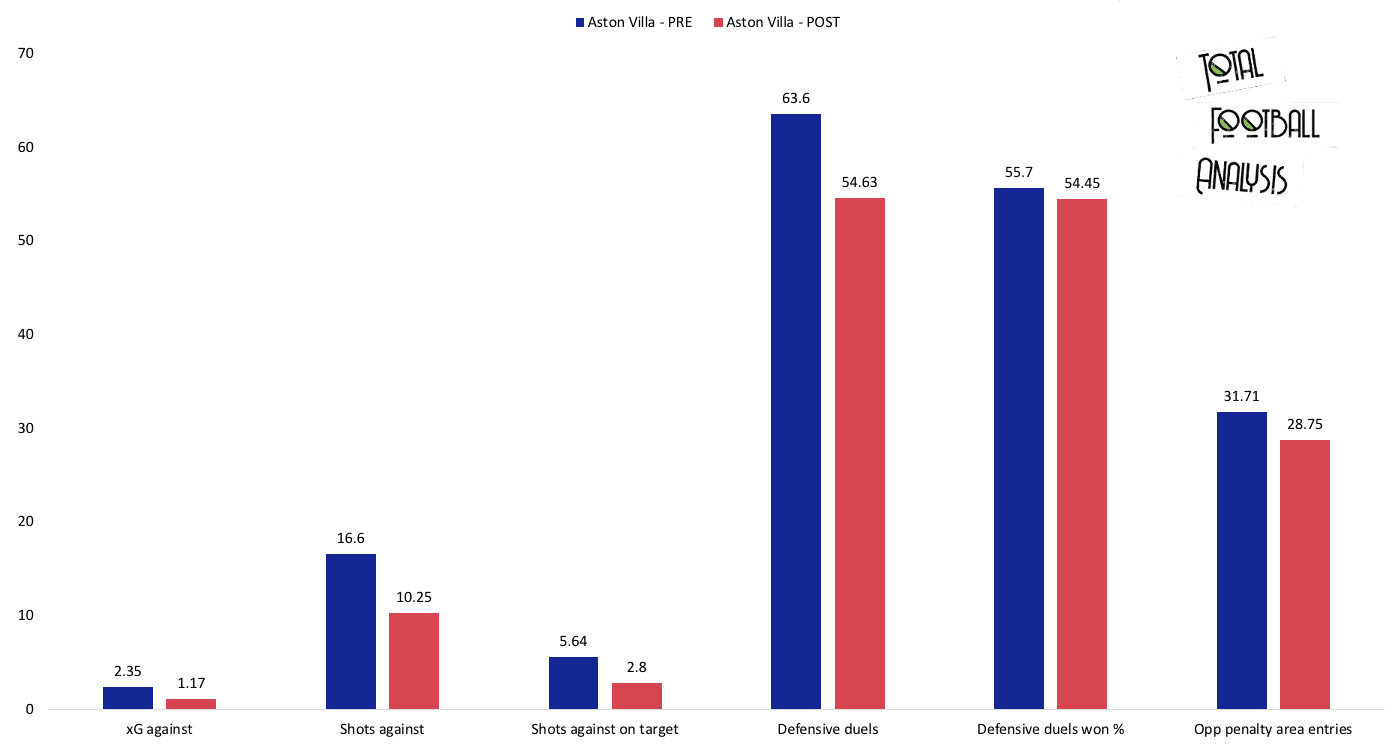
Despite spending nearly £140m in the summer, Villa had a real issue. They could simply not keep the ball out of their net. Whilst they were not setting the world alight at the other end of the pitch, Dean Smith knew this is where he had to focus his attention. Smith claims he held personal tactics meetings to address these problems, and it most certainly worked. The analysis above shows how Villa improved defensively, after the break. All metrics are per 90.
The most startling statistic is the number of xG against. Before lockdown occurred, Villa conceded an xG of 2.35 per 90. This was by far one of the worst in the league. However, after the restart, that value dropped to 1.17 per 90. A huge improvement in a particularly important area. How Villa got into this position is also interesting.
The analysis above again shows Villa’s defensive frailties before the break. They were conceding 16.6 shots per 90. After the Everton game, this value sat at only 10.25 per 90. Another massive improvement in the defensive department. Next, we have the number of shots on target conceded, as this is where Villa really jump out. They conceded the highest number of shots on target, before the break, with 5.64 per 90. This value was the highest in the league. However, after the restart, Villa managed to bring this down to an astonishing 2.8 per 90. This is only beaten by the likes of Wolves and Manchester City, who had 2.22 and 2.5 per 90, respectively.
Surprisingly, Villa engaged in fewer defensive duels after the restart, with only 54.63 per 90, compared to 63.6 per 90. They also won fewer defensive duels as their success rate fell from 55.7% to 54.45%. An unexpected piece of data, however, it suggests Villa found their success in other ways. On the other hand, they did limit the number of times the opposition penetrated their box. Bringing the number of entries down from 31.71 per 90 to 28.75 per 90. Another example of their improved defensive capabilities.
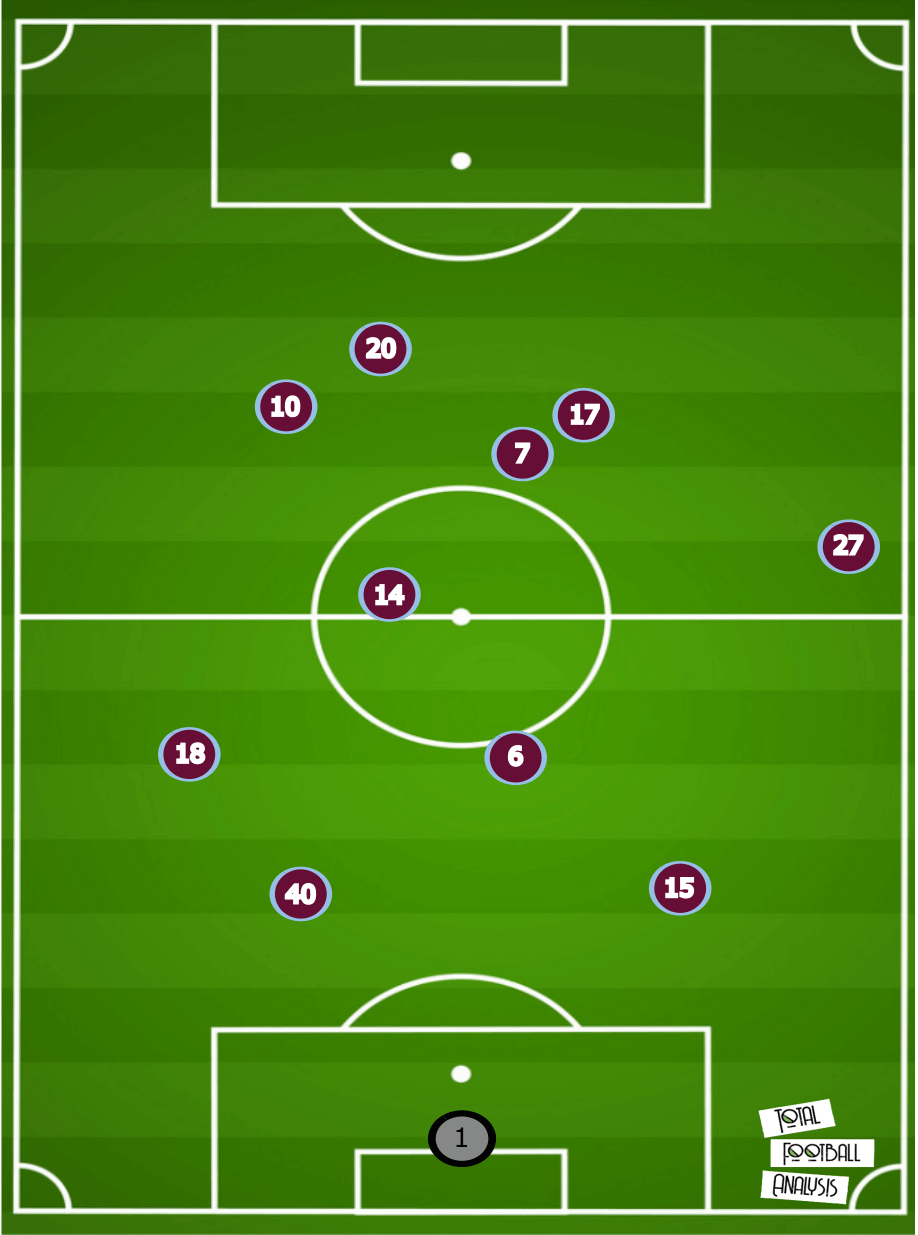
It is clear that Villa were improved defensively and is without a doubt one of the reasons they stayed up. However, not too much changed for them. They stuck with a 4-3-3 formation and no drastic changes were made to the line-up. So, with Villa relatively unchanged regarding personnel, what was a driving factor in their resurgence? The graphic above shows the average position for Villa in their match against Everton.
Douglas Luiz, 6, takes up a very deep role and almost acts as a shield for the defence. When his teammates push forward, such as full-back Ahmed Elmohamady (27), we can see that he drops deeper to add defensive solidity. This awareness was something that Luiz possibly lacked in the first part of the season. His greater understanding of the role after the restart is what enabled him to be so successful.
Douglas Luiz data analysis
This section will analyse Douglas Luiz, and how his performance changed after the break. We will also consider how Luiz compared to other defensive midfielders in the Premier League, pre and post lockdown. All players included in the data must have played at least 1000 minutes, and the data is from matches up to matchday 36. For clarity, in the following analysis, Douglas Luiz’s performance before the break is highlighted by blue markers, and performance after the restart is indicated by red markers.
A majority of the analysis will focus on defensive metrics, as this role of a lone defensive midfielder is one Luiz adopted after the restart.
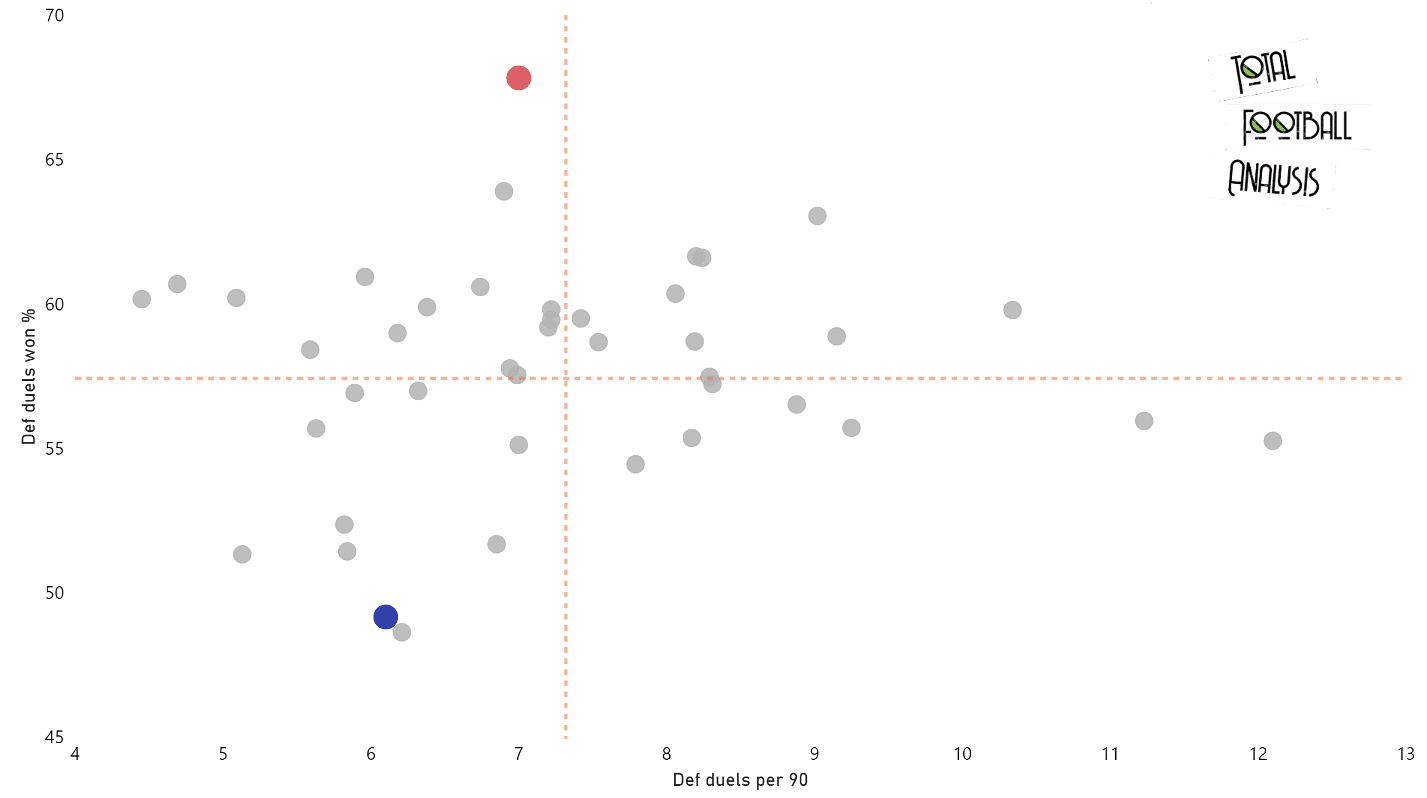
First, we begin with defensive duels. As discussed earlier, Villa engaged in less defensive duels and had a lower success rate following the restart. However, this is not the case with Douglas Luiz. Before the break, the Brazilian had one of the lowest defensive duels won % with 49.18%. This was extremely poor for a defensive midfielder, only beaten by Arsenal midfielder Granit Xhaka. The Swiss only won a meagre 48.65%. Luiz also engaged in a relatively low number of defensive duels, only attempting 6.10 per 90. The average for the Premier League was 7.32 per 90, so Luiz was way off this. Players such as Tom Trybull and Fred completed extremely high numbers with 12.10 and 11.23 per 90, respectively.
Amazingly, after the restart, Douglas Luiz had the highest defensive duels won %, with a staggering 67.85%. The 22-year old won almost 20% more defensive duels, which is surprising as Villa lost more. This success % is by far the highest in the league for defensive midfielders, only challenged by Chelsea’s Mateo Kovačić with 63.92%. Furthermore, this success was far greater than the league average of 57.44%.
Luiz also began to engage in more defensive duels, going from 6.10 to 7 per 90. Whilst still lower than the league average, it certainly shows how the Brazilian upped his defensive approach.
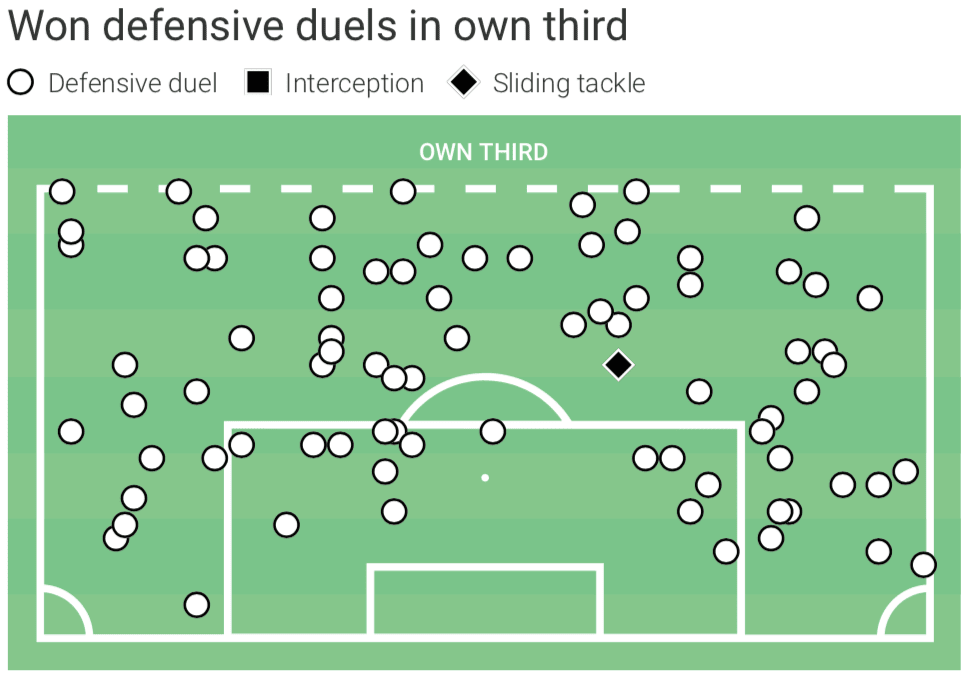
The map above shows an example of Douglas Luiz’s defensive duels in his own third. These duels are primarily only defensive duels, rather than interceptions or slide tackles. However, the areas of these duels are also interesting. In the 83 duels above, 31 of these are won in ‘Zone 14’. This zone is also known as the ‘hole’ and occupies the space on the edge of the box in front of goal. Being such a dangerous area of the pitch, defensive teams often look to close this space down as fast as possible. Further to this, Luiz also wins many defensive duels on both flanks and in the penalty area. He had a much greater understanding of his role and his need to ‘plug gaps’ when teammates were displaced. This is supported by the high range of areas in which he wins his defensive duels.
Next, we will look at another defensive metric, which is one we just mentioned. Whilst Luiz does not appear to win many interceptions in his own third, it is something he has massively improved on.
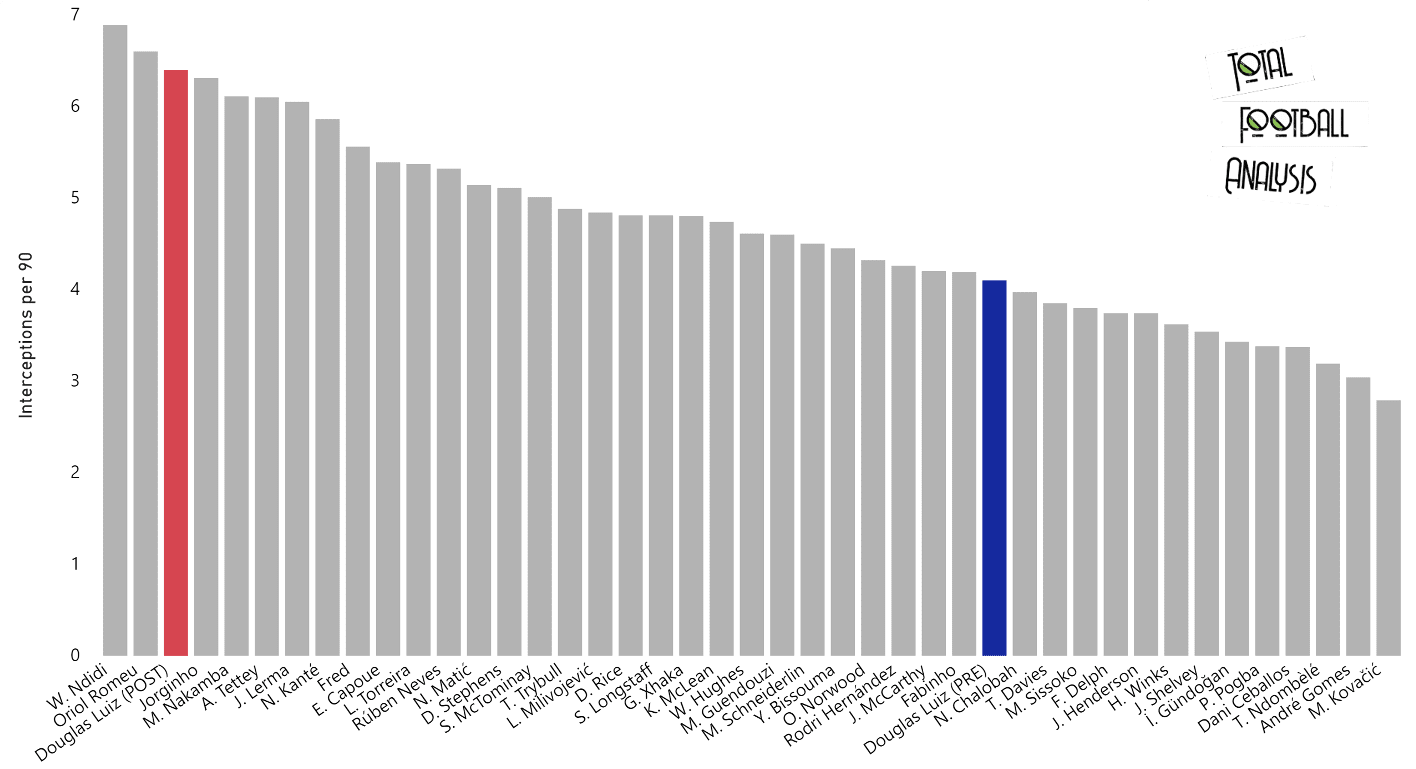
The analysis above shows the drastic improvement Luiz has made in interceptions. Before lockdown, Luiz was averaging 4.10 interceptions per 90. This was one of the lowest in the league for defensive midfielders. Many of the players averaging fewer than Luiz played for clubs in the top six. Presumably because they dominated a majority of games and therefore there is little need for a high number of interceptions. Players such as Jordan Henderson and Paul Pogba only averaged 3.74 and 3.38, respectively. However, Luiz was not in a top-six team and Villa needed someone who could win the ball back at every opportunity.
After the restart, Luiz increased his number of interceptions per 90 by over 2. Post lockdown Luiz was averaging 6.40 interceptions per 90. This was the third-highest in the league. Only beaten by Wilfred Ndidi with 6.89 per 90 and Oriol Romeu with 6.60 per 90.
Aston Villa also had another player performing well in this region in Marvelous Nakamba. Throughout the season Nakamba averaged 6.11 interceptions per 90. This is a much more impressive figure than Luiz, pre-lockdown. Apart from those mentioned above, Nakamba was only bettered by Jorginho with 6.31 per 90. Nakamba did not enjoy as much game time as Luiz throughout the season, despite appearing better defensively across the course of the season. Smith clearly believed Luiz was capable of being his defensive anchor and his trust was repaid after the break.
The analysis so far has focused on how Luiz has improved defensively. However, we will now focus on an attacking style metric that may highlight his improved defensive capabilities. We saw earlier in the analysis that Luiz’s key role was to shield the defence. Villa were more than comfortable to allow players, such as John McGinn, to push forward and support the attackers.
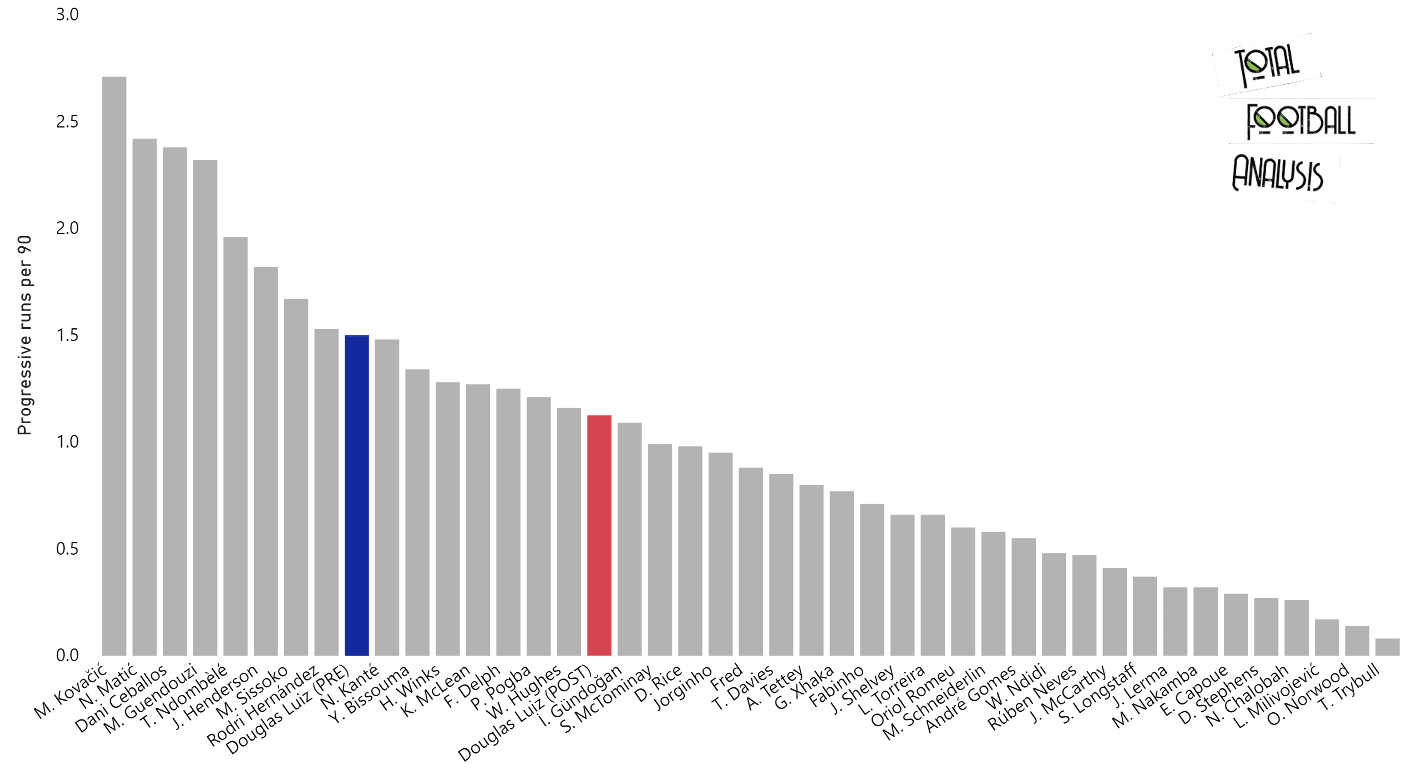
Above, we have used statistics to examine the number of progressive runs. Progressive runs would suggest a player is responsible for carrying their team up the pitch, however, this is not what Luiz was tasked to do. The data above shows how Luiz completed fewer progressive runs after the break. Before lockdown, Luiz was completing 1.50 progressive runs per 90. This placed him in the top 10 of defensive midfielders. However, you only need to see the type of players around him to understand why this may not be a positive. Apart from Dani Ceballos and Matteo Guendouzi, every player with more progressive runs than Luiz played for a top-six team. Kovačić tops the chart with 2.71 per 90, followed closely by Nemanja Matić with 2.42 per 90.
Luiz was not in a team that could afford this luxury and trusted players, such as Jack Grealish, to move the team up the pitch. After the break, Luiz was able to bring this number down to 1.13 per 90. Whilst not a significant reduction, it does show that Luiz was more aware of his defensive responsibilities. The Brazilian was still completing far more than his Zimbabwean teammate, as Nakamba only averaged 0.32 progressive runs per 90. However, the Villa boss will be happy with the improvement Luiz made in a short space of time.
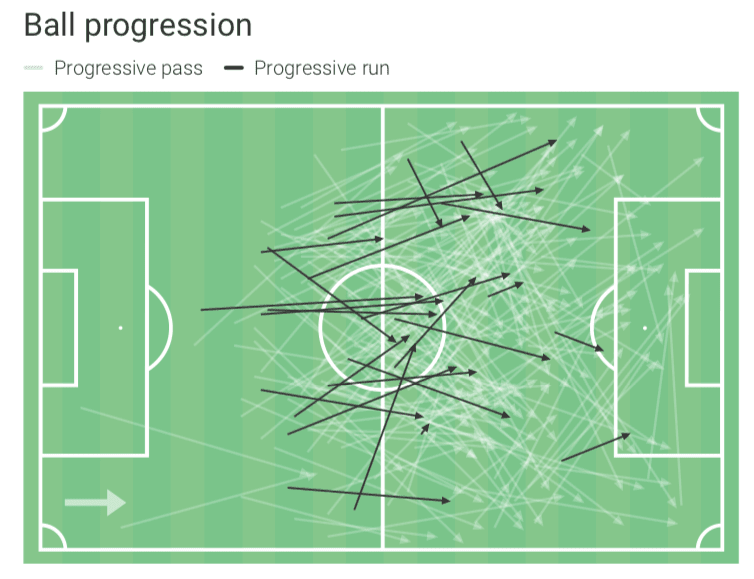
The ball progression graphic above may indicate that Luiz attempted several progressive runs, however, his progressive passes equalled 230 compared to 26 progressive runs. Luiz was also much more successful with his passes, completing 77.8% of them. He was also much more successful in his long-distance passing, completing 97.1% of passes over 40m. He also completed 95.6% of passes between 30-40m. A majority of the 22-year old’s progressive runs resulted in a loss, with Luiz losing 60.9% of them. Only 31.3% of the progressive runs resulted in an accurate pass. So, whilst this change made Luiz more defensive, it also removed some flaws from his game. Dean Smith was able to make Luiz release the ball earlier, therefore keeping possession more often and also keeping Luiz as his defensive anchor.
Finally, we will look at statistics which were not available for all other defensive midfielders. Again, the data focuses on the defensive aspect of Luiz’s game. All metrics are per 90.
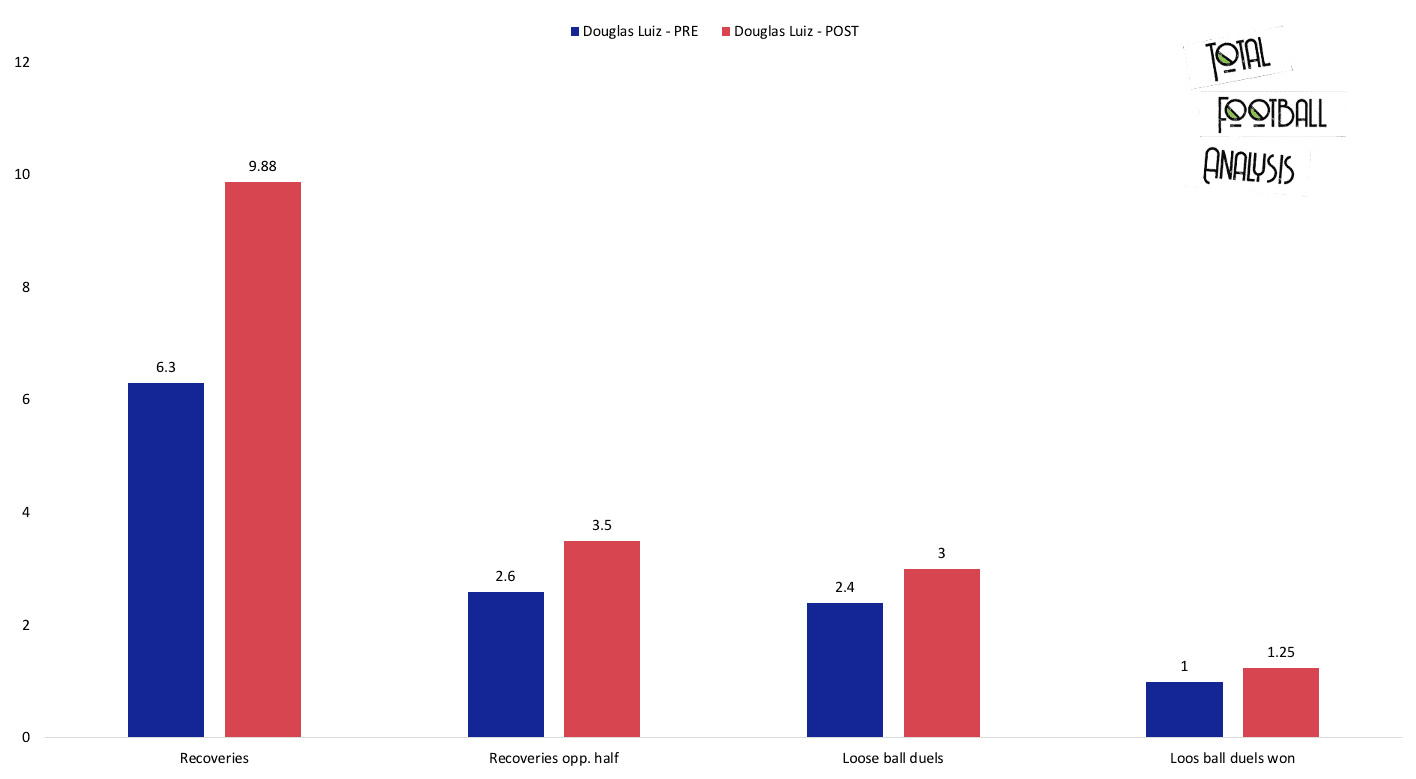
Instantly, we see a huge improvement in two other key areas for Luiz. Firstly, we will consider the number of recoveries. Before lockdown, Luiz was averaging only 6.3 recoveries per 90. After the restart, this value went up to 9.88, a huge improvement of over 3 per 90. Further to this, Luiz also started to win the ball higher up the pitch. His recoveries in the opposition half went from 2.6 to 3.5 per 90. At the end of the season, Luiz finished with the 50th most recoveries in the league for all midfielders. However, if he was able to sustain the rate he was achieving after the restart, he would surely be much higher up the table.
Secondly, we have an extremely important metric for a relegation-stricken team. The Brazilian only engaged in 2.4 loose ball duels per 90 before the break. However, post lockdown this value increased to 3 per 90. This is extremely important for a team like Aston Villa, as the opportunity to win the ball back in almost a 50/50 situation could be the difference. The 22-year old was not only involved in more duels, but he also appeared to win more. However, Luiz originally won 1 of the 2.4 duels per 90, leaving him with a success rate of 41.6%. After the restart, he won 1.25 of 3 per 90, also leaving him with a 41.6% success rate. Whilst the % did not increase, Luiz was more engaged which was only a positive for Villa.
Conclusion
This data analysis aimed to explore how Douglas Luiz was a key figure in Aston Villa’s dramatic survival. It was clear Villa were a much stronger outfit defensively, preventing more shots and ultimately conceding fewer goals. As a team, they were much improved, however, the rich vein of form from Douglas Luiz was certainly a key aspect. Luiz improved in almost all defensive situations, most notably winning more defensive duels and completing more interceptions.
He seemed to have a greater understanding of his defensive duties and it showed in the statistics. Villa now have the chance to try and put things right next season, and will be hoping Luiz is the man in the centre of all that.





Comments